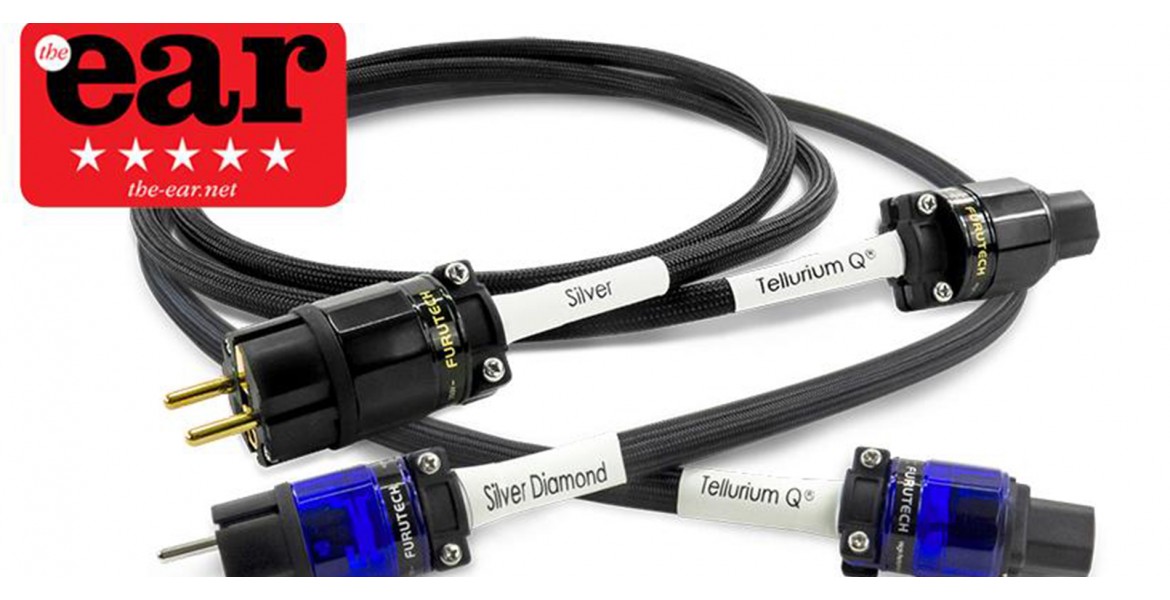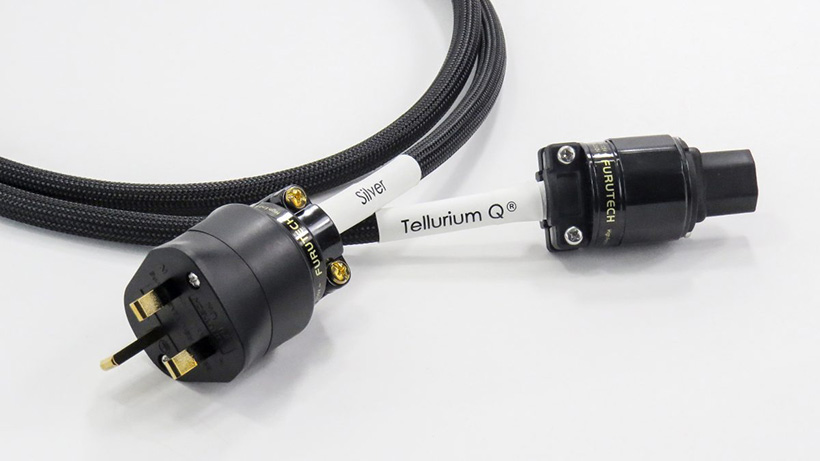- Home
- About us
- Blog
- Shop
-
- Brands
- ALL Brands List
- Acoustical Systems
- Analog Relax
- Antipodes Audio
- Astell & Kern
- Audio Solutions
- AudioByte
- AudioCircle
- Audiomica Laboratory
- Canary Audio
- Canor Audio
- Chameleon Audio
- Clarisys Audio
- CSPort
- Dan D'agostino
- Eversolo
- Farad Power Supplies
- Ferrum Audio
- Fezz Audio
- Fonolab
- Glanz
- HiFiMAN
- HoloAudio
- LAB 12
- LAIV
- LampizatOr
- Magico
- Mega Acoustic
- Monrio Audio
- OLIO SPEC
- Origin Live
- Pachancko Labs
- Phasemation
- Pink Faun
- PLiXIR
- Qualiton
- Questyle
- Reed
- Remton
- Revival Audio
- Riviera Audio
- Rockna Audio
- Sbooster
- Shelter
- Sigma Acoustics
- Signal Projects
- SOtM Audio
- Soulsonic Speakers
- Soundtastic (Struss Audio)
- SPEC
- Synthesis
- Takatsuki
- Takumi
- Tedeska
- Tellurium Q
- Trafomatic Audio
- Tsakiridis Devices
- Volumio
- Second Hand Deals
- Account

5-Stars From The Ear: Tellurium Q Silver/Silver Diamond Power Cords
Power cables
Late last year Tellurium Q MD Geoff Merrigan asked if I would like to hear his new Silver Diamond mains cable and compare it with the Silver, which sits below it in the well-mapped Tellurium Q product hierarchy. It took me less time to accept his offer than it took me to type this sentence. As it turned out, Geoff had business in Exeter to attend to so took the opportunity to visit me here in Dawlish and bring the two cables with him. We had a very pleasant couple of hours, listening to the system that was here at the time, which included his own Tellurium Q Ultra Black II speaker cables and both XLR and RCA interconnects from the same range.
Geoff seemed to like what heard, and in due course left me to carry on with my reviewing. As usual, Geoff did not give me any details about what he has done with these cables you will search in vain for details of the geometry or make-up of any Tellurium Q cable. His last words before he left were “Let your ears be the judge”.

Physically, the two cables are quite easy to tell apart. The Silver is chunky, but thinner than the Silver Diamond, which feels a lot more substantial in the hand but is as a result slightly less flexible. Both are terminated with Furutech F1-UK-1363 mains plugs and Furutech F1-11-N1 IEC connectors, but on the Silver they are the G version and on its big brother they are the R variant. In other words, the terminating hardware is very high quality, as it should be, in cables at this price point. Sound quality At the time, my system looked like this: Linn Sondek LP12 with Lingo 4 PSU, Gold Note PH10 phono stage with PSU10 external power supply, Naim NDX, Yamaha CD-S3000 SACD/CD player and Yamaha A-S3000 integrated amplifier, with my trusted Harbeth P3ESR loudspeakers supported by a REL305SE subwoofer.
I have a four way mains outlet close to the system, with two mains blocks attached, one for AV components and one for the audio system. The two spare sockets I usually use to connect my amplifier and one other component plugged in directly with the others making use of the mains block.

I started the review time by plugging the less expensive Silver cable into the Yamaha amplifier and then into one of the spare wall sockets. When I sat down to listen I immediately noticed that the sound was a definite improvement on what I had heard in the morning, when the power was coming through a well-respected but much less expensive cable. What does ‘improvement’ mean in this context? I noticed a slight increase in speed and bass slam, and a little more detail coming through from tracks that I know well. Not one of those jaw-dropping moments so beloved of we audio fools, but a worthwhile improvement nonetheless. I spent a couple of hours playing records and streaming through the NDX and both sources sounded slightly more convincing with the Silver cable in the amplifier.
The next day I took out the Silver cable and plugged in the heavier Silver Diamond, and sat down to listen to the same music which I had enjoyed the previous day. Good heavens, this was no subtle improvement. The Yamaha seemed to have somehow gained volume and resolving capability and the music was absolutely cascading from the Harbeth’s small main drive units in a way that I had not previously heard. This was a serious sit up and take notice moment. I sat down just after nine in the morning and did not leave the listening room for five hours, by which time my need for both a comfort break and a caffeine infusion eventually overwhelmed me.
Playing vinyl for the most part, I found myself working through a whole swathe of Mobile Fidelity pressings, both 33.3 and 45 rpm, as well as the Giles Martin reworking of Sgt. Pepper’s…, David Gilmour’s Live at Gdansk, and a few other favourites.

Then I wondered to myself what would happen if I put the Silver Diamond into the Gold Note PSU and the Silver into the amplifier? So I did that, with both cables plugged directly in to the wall socket, and put on Bob Dylan’s Blood On the Tracks in its MFSL pressing. Crikey. His Bobness was palpably in the room with me, with the different guitars, bass and drums absolutely anchored to their space in the soundstage. From then on I was up and down changing records after a song or two (not my normal practice) in order to see how song X or Y from one of the other albums in the play pile would sound. In every case the appropriate word was ‘sensational’.
Over the ensuing days and weeks I tried the cables in different combinations on the other sources, including the Linn Lingo 4. Improvements were audible in all of them when I swapped in the Silver cable and had the Silver Diamond in the amplifier. The noise floor of each component seemed to drop and somehow the music seemed to flow more effortlessly. I tried each component with the Silver Diamond too with the Silver powering the amplifier. I really could not say that the other components sounded any better with that combination, except the Gold Note phono stage. Coming back to that with the better cable confirmed what I had heard previously and took vinyl reproduction to a new level for me at home. I know that there are plenty of you reading this who are sceptical about how much difference that last metre and half of wire from the wall socket to the component can possibly make to the sound of your system.
If you have listened and heard no difference then I totally respect that. If however, you are dismissing it prior to your own investigation I urge you, when circumstances permit, to try this for yourself. You may be pleasantly surprised. I am also aware that the Silver Diamond retails for more than £2,000 here in the UK, which is serious money for most of us. Is it worth it, to be truthful, I think that it is. Why, because if you have a system at an appropriate level, Silver Diamond will extract the performance of which it is truly capable. If your system is like mine, higher than entry level but well below the truly esoteric levels that can be found in many audiophile systems, the Tellurium Q Silver (which is itself over £1,000) will give you a glimpse behind the high-end curtain. Either way, I have no hesitation in the thoroughly recommending these two fine cables. In the right context they might turn out be the best ‘bang for buck’ upgrade you could buy.
SPECIFICATIONS:
Type: mains power cables
Connectors: Furutech F1-UK-1363 13A mains, Furutech F1-11-N1 IEC
Length: 1.5m
Options: Furutech US & EU power plugs
Shop Tellurium Q Power Cables HERE!
